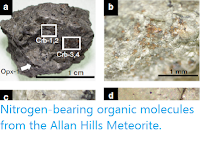Asteroid 2019 JH7 passed by the Earth at a distance of about 11 573 000
km (30.1 times the average distance between the Earth and the Moon, or 7.74% of the distance between the Earth and the Sun), slightly before 4.30 pm
GMT on Tuesday 12 May 2020. There was no danger of
the asteroid hitting us, though were it to do so it would not have
presented a significant threat. 2019 JH7 has an estimated
equivalent
diameter of 2-7 m (i.e. it is estimated that a spherical object
with
the same volume would be 2-7 m in diameter), and an object of this
size
would be expected to explode in
an airburst (an explosion caused by superheating from friction with the
Earth's atmosphere, which is greater than that caused by simply
falling, due to the orbital momentum of the asteroid) in the atmosphere more than 36 km above the ground, with only fragmentary material
reaching the Earth's surface.
Asteroid 2019 JH7 imaged on 15 May 2019 from London, England. Image is a composite made up of 40 one second exposures. Asteroid is the short solid line indicated by the red circle, which has moved only slightly over the course of the image gathering, while the longer lines of dots are stars that have moved considerably in the same time. Northolt Branch Observatories/Facebook.
2019 JH7 was discovered on 14 May 2019 by the
University of Arizona's Mt. Lemmon Survey at the Steward Observatory on Mount
Lemmon in the Catalina Mountains north of Tucson. The designation 2019 JH7 implies that the asteroid was the 176th object (asteroid H7 -
in numbering asteroids the letters A-Y, excluding I, are assigned
numbers from 1 to 24, with a number added to the end each time the
alphabet is ended, so that A = 1, A1 = 25, A2 = 49, etc, which means that H7 = (24 x 7) + 8 = 176) discovered in the first half of May 2019 (period 2019 J - the
year being split into 24 half-months represented by the letters A-Y, with I being excluded).
2019 JH7 has a 360 day (0.99 year) orbital period, with an elliptical orbit tilted at
an angle of 0.85° to the plain of the Solar System which takes in to
0.70 AU from the Sun (70% of the distance at which the Earth orbits the
Sun, and slightly inside the orbit of the planet Venus) and out to
1.28 AU (28%
further away from the Sun than the Earth). This means that close
encounters between the asteroid and Earth are fairly common, with the
last thought to have happened in May 2019 and the next predicted
in May 2021. Although it does cross the Earth's
orbit and is briefly
further from the Sun on each cycle, 2019 JH7 spends most of its time
closer to the Sun than we are, and is therefore classified as an Aten
Group Asteroid. The asteroid also has
occasional close encounters with the planet Venus, with the last
having happened in July 2017, and the next predicted for July this year (2020).
See also...
Follow Sciency Thoughts on Facebook.








